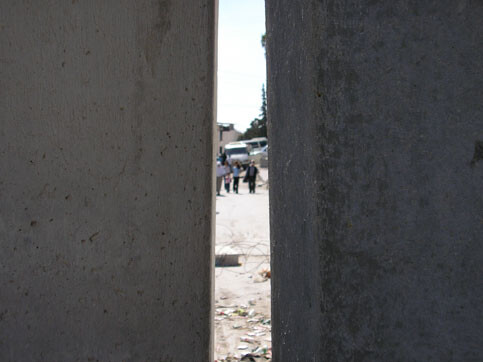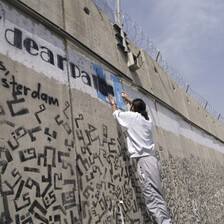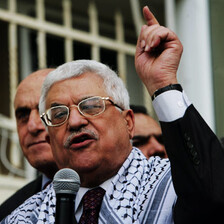The Electronic Intifada 10 July 2005

Prime Minister Ariel Sharon has called for workers to speed up building the Wall. The Israeli cabinet set September 1, 2005 as completion date for the Wall in and around Jerusalem. (Arjan El Fassed)
One year after the ruling of the International Court of Justice (ICJ), in which it made clear that the construction of the Wall and the settlements were illegal, the Israeli cabinet called for “the immediate completion of the security fence [sic] in the Jerusalem area”.
With this decision, Israel, once again, defies international law and the advisory of opinion of the ICJ, backed by the General Assembly of the United Nations, which ruled that Israel should not only immediately stop with its construction, but also begin dismantling them and to pay reparations to those who had lost their property as the result of the Wall’s construction.
Once completed, the total length of the new barrier route will be 670 km long. This includes the sections around the Israeli settlement Ma’ale Adumim and Ariel/Emmanuel settlement ‘fingers’. Together these two areas total 108 km or 16 percent of the route or 10.1 percent of the West Bank and East Jerusalem that will lie between the Wall and the 1949 Armistice Line (also referred to as “Green Line” or the 1967 border). This land constitutes some of the most fertile in the West Bank. It is currently home for more than 55,000 Palestinians, living in 38 villages and towns.
Where the Wall has been constructed, Palestinians face economic hardship from being restricted from or not being able to reach their land to harvest crops, graze animals or earn a living. Residents have also been cut off from schools, universities and specialized medical care by the constructed Wall. It also fragments communities and isolates residents from social support networks.
In its ruling, the International Court of Justice noted in paragraph 163, that: “Israel is under an obligation to terminate its breaches of international law; it is under an obligation to cease forthwith the works of construction of the Wall being built in the Occupied Palestinian Territory, including in and around East Jerusalem, to dismantle forthwith the structure therein situated, and to repeal or render ineffective forthwith all legislative and regulatory acts relating thereto.”
To date, Israel has failed to comply with the ICJ advisory opinion. The ICJ ruling of July 9, 2004, was a step in the right direction but the international community has failed to take further action. The Wall is preventing thousands of Palestinians from reaching their workplaces, schools, hospitals and relatives. It undermines the economy, erodes livelihoods and increases suffering in a population of which half already live below the poverty line of two dollars a day.
Today’s decision by the Israeli cabinet backed concerns about the implications of the Gaza Disengagement Plan as a smokescreen for subsequent violations of international law and human rights law in the West Bank and occupied East Jerusalem. The consequences of this are that the two-state solution has no practicable meaning on the ground. The implications of this include a worsening of the situation of ordinary Palestinians and little reason to regard the Disengagement Plan as a genuine step towards an end to Israel’s occupation of Palestine.
Prime Minister Ariel Sharon has called for workers to speed up building the Wall. The Israeli cabinet set September 1, 2005 as completion date for the Wall in and around Jerusalem. More than 230,000 Palestinians hold East Jerusalem residency permits. About one-quarter of these people are located on the West Bank side of the Barrier and will need to cross the Barrier to access to services which they are entitled inside Jerusalem. The Barrier will also affect those people living east of it who may need to cross it to get to their farms, jobs and services. More than 500,000 Palestinians, for example, live within a one kilometre strip of the Barrier.
Extending 14 km east across the most narrow section of the West Bank, the planned Ma’ale Adumim section will impede movement between the northern and southern areas of the West Bank, blocking the current roads used by Palestinians to travel between these areas.
For Palestinians residing in and around East Jerusalem, the addition of the Ma’ale Adumim section will increase existing movement restrictions created by the constructed parts of the Wall. Stretching a total of 670 kilometres, the Wall will run from the northern Jordan River in Eastern Tubas to the southernmost tip of the West Bank in the Hebron Governorate. Because of its meandering path into the West Bank, the Barrier’s length is approximately twice the length of the 1949 West Bank Armistice Line adjacent to Israel, known as the Green Line - 315 km. Only 20% of the Wall’s length runs along the 1949 Armistice Line.

Map of the Wall cutting through occupied East Jerusalem. (Map: UN OCHA)
In the planned Ari’el/Emmanuel finger, the Wall extends 22 km or 42% across the width of the West Bank. In the planned Ma’ale Adumim section, the Barrier route extends into the West Bank 14 km or 45% of its width. In areas where the Wall has been constructed, Israeli occupation forces issued military orders in September 2004, creating a strip averaging 150-200 metres on the West Bank sides of the Barrier where new construction is prohibited.
Palestinians who live in “closed areas” are required to pass through gates in the Barrier to reach markets, schools, hospitals and maintain family connections in the remaining areas of the West Bank.
With the addition of the Ma’ale Adumim section, 56 West Bank Israeli settlements (excluding East Jerusalem settlements) will lie between the Wall and the 1949 Armistice Line also known as “The Green Line”. This comprises 76% of the West Bank settler population or 170,123 Israeli settlers. In addition, there are over 170,000 Israeli settlers in East Jerusalem settlements who will be between the Wall and the 1949 Armistice Line.
Even with the $3 billion approved by G8 leaders in Scotland last week — an aid package that is intended to help revitalize the Palestinian economy after Israel implements Sharon’s disengagement plan — the damage caused by the destruction of land and property for the Wall’s construction will take many years to recover and hinder Palestinian development. Moreover, the Israeli cabinet gave its final blow to the two-state vision, once again embraced by G8 leaders last week, included in the internationally backed Road Map.
Arjan El Fassed is one of the founders of The Electronic Intifada
Related Links



